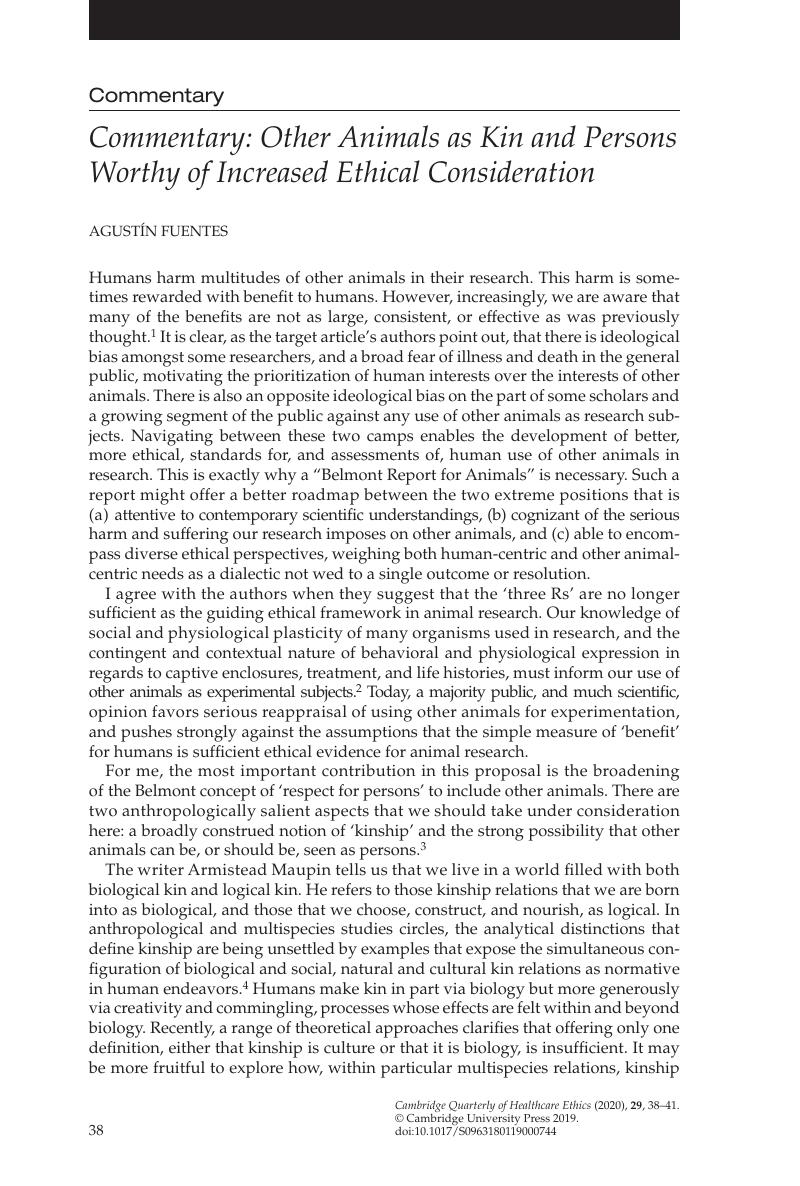Published online by Cambridge University Press: 20 December 2019

1. Ferdowsian, H, Fuentes, A. Harms and deprivation of benefits for nonhuman primates in research. Theoretical Medicine and Bioethics 2014;35(2):143–56, See alsoCrossRefGoogle ScholarPubMed Ferdowsian, HR, Gluck, JP. The ethical challenges of animal research: Honoring Henry Beecher’s approach to moral problems. Cambridge Quarterly of Healthcare Ethics 2015;24:391–406. See alsoCrossRefGoogle Scholar Ferdowsian, H, Johnson, SM, Johnson, J, Fenton, A, Shriver, A, Gluck, J. A Belmont Report for animals? Cambridge Quarterly of Healthcare Ethics 2020;29(1):19–37.CrossRefGoogle Scholar
2. For the example of monkeys, see Ferdowsian, Fuentes 2014.
3. Here I am explicitly not making an argument for legal personhood that has come to be common recently. The legal realm is a separate context and set of assertions from the one I present here.
4. Fuentes, A, Kinship, Porter N. In: Gruen, L, ed. Critical Terms for Animal Studies. Chicago, IL: The University of Chicago Press 2018;182–96.Google Scholar
5. See note 4, Fuentes, Porter 2018; and Fuentes, A. Holobionts, multispecies ecologies, and the biopolitics of care: Emerging landscapes of praxis in a medical anthropology of the Anthropocene. Medical Anthropology Quarterly 2019;33:156–62CrossRefGoogle Scholar
6. Haraway, D. When Species Meet. Minneapolis, MN: University of Minnesota Press; 2007. See alsoGoogle Scholar Haraway, D. Staying with the Trouble: Making Kin in the Chthulucene. Raleigh, NC: Duke University Press; 2016.CrossRefGoogle Scholar
7. Cortez, A, Fuentes, A. Of primates’ bodies: Forms of human-other primate intercorporeality. In: Ohrem, D, Calarco, M, eds. Exploring Animal Encounters. Palgrave Studies in Animals and Literature. New York, NY: Palgrave Macmillan; 2018:233–52. See alsoCrossRefGoogle Scholar Cormier, LA. Kinship with Monkeys: The Guajá Foragers of Eastern Amazonia. New York, NY: Columbia University Press; 2003. See alsoCrossRefGoogle Scholar Descola, P. In the Society of Nature: A Native Ecology in Amazonia. Cambridge, UK: University of Cambridge Press; 1994. See alsoGoogle Scholar Descola, P. Beyond Nature and Culture. Chicago, IL: The University of Chicago Press; 2013. See alsoCrossRefGoogle Scholar Fuentes, A. Naturecultural encounters in Bali: Monkeys, temples, tourists, and Ethnoprimatology. Cultural Anthropology 2010;25:600–24;CrossRefGoogle Scholar Kohn, E. How Forests Think: Toward an Anthropology Beyond the Human. Oakland, CA: University of California Press; 2013;CrossRefGoogle Scholar Locke, P. Multispecies Methodologies and Human-Elephant Relations. Engagement Blog 2015; available at https://aesengagement.wordpress.com/2015/10/27/multispecies-methodologies-and-human-elephant-relations/ (last accessed 1 May 2019);Google Scholar Nadasdy, P. The gift in the animal: The ontology of hunting and human-other animal sociality. American Ethnologist 2007;34:25–43;CrossRefGoogle Scholar Viveiros de Castro, E. Cosmological Deixis and Amerindian Perspectivism. The Journal of the Royal Anthropological Institute 1998;4:469–88.CrossRefGoogle Scholar
8. See note 7, Kohn 2013.
9. See note 7, Philippe 2013.
10. See, for example, Fuentes, A. How humans and apes are different, and why it matters. Journal of Anthropological Research 2018;74:151–67.CrossRefGoogle Scholar